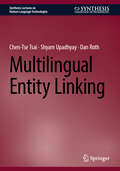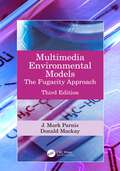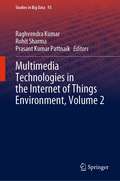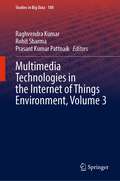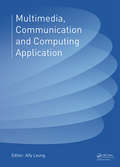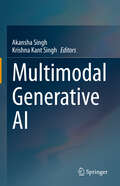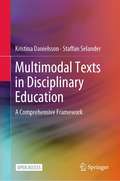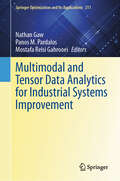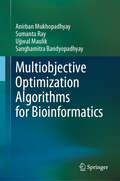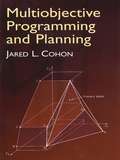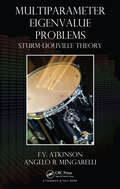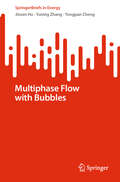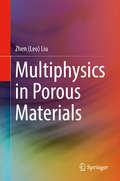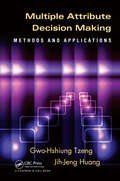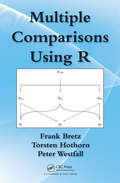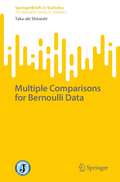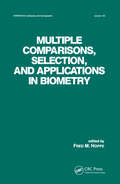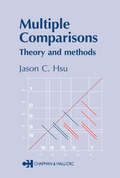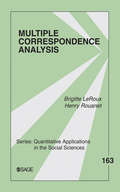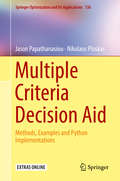- Table View
- List View
Multilingual Education Yearbook 2021: Policy and Practice in STEM Multilingual Contexts (Multilingual Education Yearbook)
by Anthony A. Essien Audrey MsimangaThis edited book attempts to foreground how challenges and complexities between policy and practice intertwine in the teaching and learning of the STEM subjects in multilingual settings, and how they (policy and practice) impact on educational processes, developments and outcomes. The unique feature of this book, thus, lies in its combination of not just language issues in the teaching and learning of the STEM subjects, but also in how these issues relate to policy and practice in multilingual contexts and how STEM research and practice may inform and shape language policies and their implementation in multilingual contexts. This book is of interest to stakeholders involved in STEM education such as researchers, undergraduate and graduate students, tertiary level teachers, teacher educators, curriculum developers as well as other professionals with responsibilities in STEM education subjects. The book is written in a way that is accessible to a wide range of backgrounds, including those who are in language education.
Multilingual Entity Linking (Synthesis Lectures on Human Language Technologies)
by Dan Roth Chen-Tse Tsai Shyam UpadhyayThis book focuses on Entity Discovery and Linking (EDL), which is the problem of identifying concepts and entities, disambiguating them, and grounding them to one or more knowledge bases (KBs). The authors first provide background on the topic and emphasize why it is a crucial step toward understanding natural language text. As most of the content on the internet is not in English, the book also discusses cross-lingual EDL. The authors present the challenges associated with EDL problems and explain the existing solutions. The book covers the core challenges that apply to all EDL problems, as well as the additional challenges associated with cross-lingual EDL problems. The authors also survey relevant research papers, highlight recent trends, and identify areas for future research.
Multimedia Environmental Models: The Fugacity Approach
by Donald Mackay J. Mark ParnisMultimedia Environmental Models: The Fugacity Approach, Third Edition, takes a broad approach of viewing chemical behavior in the total biosphere of connected biotic and abiotic compartments. Chemicals are subject to the laws of "mass balance," a constraint that provides the opportunity to establish quantitative expressions for chemical fate that are central to chemical management and regulatory legislation. This book employs both the conventional concentration-based procedures and those based on application of the more elegant and powerful concept of fugacity to characterize equilibrium, steady-state distribution, and time-dependent transport between environmental phases such as air, water, and soil. Organic chemicals are emphasized because they are more easily generalized when assessing environmental behavior.Features Illustrates professional approaches to calculating the fate of chemicals in the environment Explicitly details all worked examples in an annotated step-by-step fashion Presents real-life freely downloadable models of use to government, industry, and private consulting professionals and students alike Clarifies symbols and notation
Multimedia Technologies in the Internet of Things Environment, Volume 2 (Studies in Big Data #93)
by Rohit Sharma Prasant Kumar Pattnaik Raghvendra KumarThis book proposes a comprehensive overview of the state-of-the-art research work on multimedia analysis in IoT applications. This is a second volume by editors which provides theoretical and practical approach in the area of multimedia and IOT applications and performance analysis. Further, multimedia communication, deep learning models to multimedia data, and the new (IOT) approaches are also covered. It addresses the complete functional framework in the area of multimedia data, IoT, and smart computing techniques. It bridges the gap between multimedia concepts and solutions by providing the current IOT frameworks, their applications in multimedia analysis, the strengths and limitations of the existing methods, and the future directions in multimedia IOT analytics.
Multimedia Technologies in the Internet of Things Environment, Volume 3 (Studies in Big Data #108)
by Rohit Sharma Prasant Kumar Pattnaik Raghvendra KumarThis book proposes a comprehensive overview of the state-of-the-art research work on multimedia analysis in IoT applications. This is a third volume by editors which provides theoretical and practical approach in the area of multimedia and IOT applications and performance analysis. Further, multimedia communication, deep learning models to multimedia data, and the new (IOT) approaches are also covered. It addresses the complete functional framework in the area of multimedia data, IoT, and smart computing techniques. It bridges the gap between multimedia concepts and solutions by providing the current IOT frameworks, their applications in multimedia analysis, the strengths and limitations of the existing methods, and the future directions in multimedia IOT analytics.
Multimedia, Communication and Computing Application: Proceedings of the 2014 International Conference on Multimedia, Communication and Computing Application (MCCA 2014), Xiamen, China, October 16-17, 2014
by Ally Leung2014 International Conference on Multimedia, Communication and Computing Application (MCCA2014), Xiamen, China, Oct 16-17, 2014, provided a forum for experts and scholars of excellence from all over the world to present their latest work in the area of multimedia, communication and computing applications. In recent years, the multimedia techno
Multimodal Generative AI
by Krishna Kant Singh Akansha SinghThis book stands at the forefront of AI research, offering a comprehensive examination of multimodal generative technologies. Readers are taken on a journey through the evolution of generative models, from early neural networks to contemporary marvels like GANs and VAEs, and their transformative application in synthesizing realistic images and videos. In parallel, the text delves into the intricacies of language models, with a particular on revolutionary transformer-based designs. A core highlight of this work is its detailed discourse on integrating visual and textual models, laying out state-of-the-art techniques for creating cohesive, multimodal AI systems. “Multimodal Generative AI” is more than a mere academic text; it’s a visionary piece that speculates on the future of AI, weaving through case studies in autonomous systems, content creation, and human-computer interaction. The book also fosters a dialogue on responsible innovation in this dynamic field. Tailored for postgraduates, researchers, and professionals, this book is a must-read for anyone vested in the future of AI. It empowers its readers with the knowledge to harness the potential of multimodal systems in solving complex problems, merging visual understanding with linguistic prowess. This book can be used as a reference for postgraduates and researchers in related areas.
Multimodal Texts in Disciplinary Education: A Comprehensive Framework
by Kristina Danielsson Staffan SelanderThis open access book provides an introduction to multimodality and the role of multimodal texts in today’s education. Presenting a comprehensive framework for analysing and working with multimodal texts in disciplinary education, it serves as a tool for researchers and teachers alike. The second part of the book focuses on sample analyses of a variety of educational texts for different age groups and from different disciplines, including games and online resources. The authors also comment on the specific challenges of each text, and how teachers can discuss such texts with their students to enhance both their understanding of the content and their multimodal literacy. The book is intended for researchers in fields like education and multimodal studies, and for teacher educators, regardless of school subject or age group. With the combined perspectives on text analysis and implications for education, the book addresses the needs of teachers who want to work with multimodal aspects of texts in education in informed ways, but lack the right tools for such work.
Multimodal and Tensor Data Analytics for Industrial Systems Improvement (Springer Optimization and Its Applications #211)
by Panos M. Pardalos Nathan Gaw Mostafa Reisi GahrooeiThis volume covers the latest methodologies for using multimodal data fusion and analytics across several applications. The curated content presents recent developments and challenges in multimodal data analytics and shines a light on a pathway toward new research developments. Chapters are composed by eminent researchers and practitioners who present their research results and ideas based on their expertise. As data collection instruments have improved in quality and quantity for many applications, there has been an unprecedented increase in the availability of data from multiple sources, known as modalities. Modalities express a large degree of heterogeneity in their form, scale, resolution, and accuracy. Determining how to optimally combine the data for prediction and characterization is becoming increasingly important. Several research studies have investigated integrating multimodality data and discussed the challenges and limitations of multimodal data fusion. This volume provides a topical overview of various methods in multimodal data fusion for industrial engineering and operations research applications, such as manufacturing and healthcare.Advancements in sensing technologies and the shift toward the Internet of Things (IoT) has transformed and will continue to transform data analytics by producing new requirements and more complex forms of data. The abundance of data creates an unprecedented opportunity to design more efficient systems and make near-optimal operational decisions. On the other hand, the structural complexity and heterogeneity of the generated data pose a significant challenge to extracting useful features and patterns for making use of the data and facilitating decision-making. Therefore, continual research is needed to develop new statistical and analytical methodologies that overcome these data challenges and turn them into opportunities.
Multiobjective Linear Programming
by Dinh The LucThis book introduces the reader to the field of multiobjective optimization through problems with simple structures, namely those in which the objective function and constraints are linear. Fundamental notions as well as state-of-the-art advances are presented in a comprehensive way and illustrated with the help of numerous examples. Three of the most popular methods for solving multiobjective linear problems are explained, and exercises are provided at the end of each chapter, helping students to grasp and apply key concepts and methods to more complex problems. The book was motivated by the fact that the majority of the practical problems we encounter in management science, engineering or operations research involve conflicting criteria and therefore it is more convenient to formulate them as multicriteria optimization models, the solution concepts and methods of which cannot be treated using traditional mathematical programming approaches.
Multiobjective Optimization Algorithms for Bioinformatics
by Ujjwal Maulik Sanghamitra Bandyopadhyay Anirban Mukhopadhyay Sumanta RayThis book provides an updated and in-depth introduction to the application of multiobjective optimization techniques in bioinformatics. In particular, it presents multiobjective solutions to a range of complex real-world bioinformatics problems. The authors first provide a comprehensive yet concise and self-contained introduction to relevant preliminary methodical constructions such as genetic algorithms, multiobjective optimization, data mining and several challenges in the bioinformatics domain. This is followed by several systematic applications of these techniques to real-world bioinformatics problems in the areas of gene expression and network biology. The book also features detailed theoretical and mathematical notes to facilitate reader comprehension. The book offers a valuable asset for a broad range of readers – from undergraduate to postgraduate, and as a textbook or reference work. Researchers and professionals can use the book not only to enrich their knowledge of multiobjective optimization and bioinformatics, but also as a comprehensive reference guide to applying and devising novel methods in bioinformatics and related domains.
Multiobjective Programming and Planning
by Jared L. CohonThis text takes a broad view of multiobjective programming, emphasizing the methods most useful for continuous problems. It reviews multiobjective programming methods in the context of public decision-making problems, developing each problem within a context that addresses practical aspects of planning issues. Topics include a review of linear programming, the formulation of the general multiobjective programming problem, classification of multiobjective programming methods, techniques for generating noninferior solutions, multiple-decision-making methods, multiobjective analysis of water resource problems, and multiobjective analysis of facility location problems. 1978 edition.
Multiparameter Eigenvalue Problems: Sturm-Liouville Theory
by F.V. Atkinson Angelo B. MingarelliOne of the masters in the differential equations community, the late F.V. Atkinson contributed seminal research to multiparameter spectral theory and Sturm-Liouville theory. His ideas and techniques have long inspired researchers and continue to stimulate discussion. With the help of co-author Angelo B. Mingarelli, Multiparameter Eigenvalue Problem
Multiphase Flow with Bubbles (SpringerBriefs in Energy)
by Yuning Zhang Jinsen Hu Yongpan ChengThis book provides a comprehensive analysis of multiphase flow with bubbles, covering bubble dynamics, sound wave propagation in vapor/gas/liquid multiphase flow, and vapor/liquid/solid multiphase flow with sand particles. It begins by introducing the cavitation nucleation mechanism and examining bubble oscillation equations in liquids, including first-order and second-order models. Further discussions explore the mass transfer effects at the bubble wall, energy dissipation mechanisms, and bubble behavior under dual-frequency acoustic fields. Regarding sound wave propagation in vapor/gas/liquid multiphase flow, the book presents a wave speed prediction model, details the solution process and propagation characteristics, and examines how vapor fraction, bubble radius, and void fraction influence critical frequency and wave speed stability. The section on vapor/liquid/solid multiphase flow delves into the bubble collapse process, analyzing jet phenomena—including single jet, multi-jet, and needle jet formations—along with shock wave phenomena occurring during cavitation bubble nucleation, splitting, and collapse. Additionally, it explores the synergistic erosion effects of cavitation bubbles and sand particles on hydraulic machinery. Designed for academic researchers and graduate students in fluid dynamics, this book consolidates core theories, physical mechanisms, and the latest advancements in multiphase flow research.
Multiphysics Modeling with Application to Biomedical Engineering
by Z. YangThe aim of this book is to introduce the simulation of various physical fields and their applications for biomedical engineering, which will provide a base for researchers in the biomedical field to conduct further investigation. The entire book is classified into three levels. It starts with the first level, which presents the single physical fields including structural analysis, fluid simulation, thermal analysis, and acoustic modeling. Then, the second level consists of various couplings between two physical fields covering structural thermal coupling, porous media, fluid structural interaction (FSI), and acoustic FSI. The third level focuses on multi-coupling that coupling with more than two physical fields in the model. Each part in all levels is organized as the physical feature, finite element implementation, modeling procedure in ANSYS, and the specific applications for biomedical engineering like the FSI study of Abdominal Aortic Aneurysm (AAA), acoustic wave transmission in the ear, and heat generation of the breast tumor. The book should help for the researchers and graduate students conduct numerical simulation of various biomedical coupling problems. It should also provide all readers with a better understanding of various couplings.
Multiphysics in Porous Materials
by Zhen Leo LiuThis book summarizes, defines, and contextualizes multiphysics with an emphasis on porous materials. It covers various essential aspects of multiphysics, from history, definition, and scope to mathematical theories, physical mechanisms, and numerical implementations. The emphasis on porous materials maximizes readers’ understanding as these substances are abundant in nature and a common breeding ground of multiphysical phenomena, especially complicated multiphysics. Dr. Liu’s lucid and easy-to-follow presentation serve as a blueprint on the use of multiphysics as a leading edge technique for computer modeling. The contents are organized to facilitate the transition from familiar, monolithic physics such as heat transfer and pore water movement to state-of-the-art applications involving multiphysics, including poroelasticity, thermohydro-mechanical processes, electrokinetics, electromagnetics, fluid dynamics, fluid structure interaction, and electromagnetomechanics. This volume serves as both a general reference and specific treatise for various scientific and engineering disciplines involving multiphysics simulation and porous materials.
Multiple Attribute Decision Making: Methods and Applications
by Gwo-Hshiung Tzeng Jih-Jeng HuangDecision makers are often faced with several conflicting alternatives. How do they evaluate trade-offs when there are more than three criteria? To help people make optimal decisions, scholars in the discipline of multiple criteria decision making (MCDM) continue to develop new methods for structuring preferences and determining the correct relative
Multiple Biological Sequence Alignment: Scoring Functions, Algorithms and Evaluation
by Yi Pan Ken Nguyen Xuan GuoCovers the fundamentals and techniques of multiple biological sequence alignment and analysis, and shows readers how to choose the appropriate sequence analysis tools for their tasks This book describes the traditional and modern approaches in biological sequence alignment and homology search. This book contains 11 chapters, with Chapter 1 providing basic information on biological sequences. Next, Chapter 2 contains fundamentals in pair-wise sequence alignment, while Chapters 3 and 4 examine popular existing quantitative models and practical clustering techniques that have been used in multiple sequence alignment. Chapter 5 describes, characterizes and relates many multiple sequence alignment models. Chapter 6 describes how traditionally phylogenetic trees have been constructed, and available sequence knowledge bases can be used to improve the accuracy of reconstructing phylogeny trees. Chapter 7 covers the latest methods developed to improve the run-time efficiency of multiple sequence alignment. Next, Chapter 8 covers several popular existing multiple sequence alignment server and services, and Chapter 9 examines several multiple sequence alignment techniques that have been developed to handle short sequences (reads) produced by the Next Generation Sequencing technique (NSG). Chapter 10 describes a Bioinformatics application using multiple sequence alignment of short reads or whole genomes as input. Lastly, Chapter 11 provides a review of RNA and protein secondary structure prediction using the evolution information inferred from multiple sequence alignments. * Covers the full spectrum of the field, from alignment algorithms to scoring methods, practical techniques, and alignment tools and their evaluations * Describes theories and developments of scoring functions and scoring matrices *Examines phylogeny estimation and large-scale homology search Multiple Biological Sequence Alignment: Scoring Functions, Algorithms and Applications is a reference for researchers, engineers, graduate and post-graduate students in bioinformatics, and system biology and molecular biologists. Ken Nguyen, PhD, is an associate professor at Clayton State University, GA, USA. He received his PhD, MSc and BSc degrees in computer science all from Georgia State University. His research interests are in databases, parallel and distribute computing and bioinformatics. He was a Molecular Basis of Disease fellow at Georgia State and is the recipient of the highest graduate honor at Georgia State, the William M. Suttles Graduate Fellowship. Xuan Guo, PhD, is a postdoctoral associate at Oak Ridge National Lab, USA. He received his PhD degree in computer science from Georgia State University in 2015. His research interests are in bioinformatics, machine leaning, and cloud computing. He is an editorial assistant of International Journal of Bioinformatics Research and Applications. Yi Pan, PhD, is a Regents' Professor of Computer Science and an Interim Associate Dean and Chair of Biology at Georgia State University. He received his BE and ME in computer engineering from Tsinghua University in China and his PhD in computer science from the University of Pittsburgh. Dr. Pan's research interests include parallel and distributed computing, optical networks, wireless networks and bioinformatics. He has published more than 180 journal papers with about 60 papers published in various IEEE/ACM journals. He is co-editor along with Albert Y. Zomaya of the Wiley Series in Bioinformatics.
Multiple Comparisons Using R
by Peter Westfall Torsten Hothorn Frank BretzAdopting a unifying theme based on maximum statistics, Multiple Comparisons Using R describes the common underlying theory of multiple comparison procedures through numerous examples. It also presents a detailed description of available software implementations in R. The R packages and source code for the analyses are available at http://CRAN.R-pro
Multiple Comparisons for Bernoulli Data (SpringerBriefs in Statistics)
by Taka-aki ShiraishiThis book focuses on multiple comparisons of proportions in multi-sample models with Bernoulli responses. First, the author explains the one-sample and two-sample methods that form the basis of multiple comparisons. Then, regularity conditions are stated in detail. Simultaneous inference for all proportions based on exact confidence limits and based on asymptotic theory is discussed. Closed testing procedures based on some one-sample statistics are introduced. For all-pairwise multiple comparisons of proportions, the author uses arcsine square root transformation of sample means. Closed testing procedures based on maximum absolute values of some two-sample test statistics and based on chi-square test statistics are introduced. It is shown that the multi-step procedures are more powerful than single-step procedures and the Ryan–Einot–Gabriel–Welsch (REGW)-type tests. Furthermore, the author discusses multiple comparisons with a control. Under simple ordered restrictions of proportions, the author also discusses closed testing procedures based on maximum values of two-sample test statistics and based on Bartholomew's statistics. Last, serial gatekeeping procedures based on the above-mentioned closed testing procedures are proposed although Bonferroni inequalities are used in serial gatekeeping procedures of many.
Multiple Comparisons, Selection and Applications in Biometry
by Fred. M. HoppeAims to provide in-depth descriptions of the latest developments in multiple comparison methods and selection procedures, while emphasizing biometry. This text is published in honour of the 70th birthday of Charles W. Dunnett - a pioneer in statistical methodology.
Multiple Comparisons: Theory and Methods
by Jason HsuMultiple Comparisons introduces simultaneous statistical inference and covers the theory and techniques for all-pairwise comparisons, multiple comparisons with the best, and multiple comparisons with a control. The author describes confidence intervals methods and stepwise exposes abuses and misconceptions, and guides readers to the correct method
Multiple Correspondence Analysis (Quantitative Applications in the Social Sciences)
by Brigitte Le Roux Henry RouanetRequiring no prior knowledge of correspondence analysis, this text provides a nontechnical introduction to Multiple Correspondence Analysis (MCA) as a method in its own right. The authors, Brigitte LeRoux and Henry Rouanet, present thematerial in a practical manner, keeping the needs of researchers foremost in mind.Key FeaturesReaders learn how to construct geometric spaces from relevant data, formulate questions of interest, and link statistical interpretation to geometric representations.They also learn how to perform structured data analysis and to draw inferential conclusions from MCA.The text uses real examples to help explain concepts.The authors stress the distinctive capacity of MCA to handle full-scale research studies.This supplementary text is appropriate for any graduate-level, intermediate, or advanced statistics course across the social and behavioral sciences, as well as for individual researchers.
Multiple Correspondence Analysis and Related Methods (Chapman & Hall/CRC Statistics in the Social and Behavioral Sciences)
by Michael Greenacre Jörg BlasiusAs a generalization of simple correspondence analysis, multiple correspondence analysis (MCA) is a powerful technique for handling larger, more complex datasets, including the high-dimensional categorical data often encountered in the social sciences, marketing, health economics, and biomedical research. Until now, however, the literature on the su
Multiple Criteria Decision Aid: Methods, Examples and Python Implementations (Springer Optimization and Its Applications #136)
by Jason Papathanasiou Nikolaos PloskasMultiple criteria decision aid (MCDA) methods are illustrated in this book through theoretical and computational techniques utilizing Python. Existing methods are presented in detail with a step by step learning approach. Theoretical background is given for TOPSIS, VIKOR, PROMETHEE, SIR, AHP, goal programming, and their variations. Comprehensive numerical examples are also discussed for each method in conjunction with easy to follow Python code. Extensions to multiple criteria decision making algorithms such as fuzzy number theory and group decision making are introduced and implemented through Python as well. Readers will learn how to implement and use each method based on the problem, the available data, the stakeholders involved, and the various requirements needed. Focusing on the practical aspects of the multiple criteria decision making methodologies, this book is designed for researchers, practitioners and advanced graduate students in the applied mathematics, information systems, operations research and business administration disciplines, as well as other engineers and scientists oriented in interdisciplinary research. Readers will greatly benefit from this book by learning and applying various MCDM/A methods. (Adiel Teixeira de Almeida, CDSID-Center for Decision System and Information Development, Universidade Federal de Pernambuco, Recife, Brazil) Promoting the development and application of multicriteria decision aid is essential to ensure more ethical and sustainable decisions. This book is a great contribution to this objective. It is a perfect blend of theory and practice, providing potential users and researchers with the theoretical bases of some of the best-known methods as well as with the computing tools needed to practice, to compare and to put these methods to use. (Jean-Pierre Brans, Vrije Universiteit Brussel, Brussels, Belgium) This book is intended for researchers, practitioners and students alike in decision support who wish to familiarize themselves quickly and efficiently with multicriteria decision aiding algorithms. The proposed approach is original, as it presents a selection of methods from the theory to the practical implementation in Python, including a detailed example. This will certainly facilitate the learning of these techniques, and contribute to their effective dissemination in applications. (Patrick Meyer, IMT Atlantique, Lab-STICC, Univ. Bretagne Loire, Brest, France)

